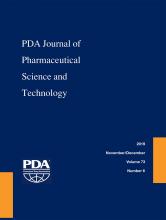Abstract
An enhancement of the glass surface chemical attack was shown in type I molded borosilicate glass containers because of the synergy between the presence of complexing agents in the aqueous solution and basic pH. However, flake development (delamination) is not easily correlated with even a strong glass surface chemical attack. A few homologue series of carboxylic and dicarboxylic acids were investigated. We considered the presence of functional groups (NH2, COOH, OH), alkyl chain length (three to six carbon atoms), and C=C bonds. Tests were performed at 0.024 M constant concentration, in the 5.8–10 pH range, in small-volume 23 mL type I molded glass containers, and by autoclaving for 1 h at 121°C. The extracted silicon data confirm that both the dissociation constant pKa and the molecular structure of the complexing agent are determinant enhancing factors of glass surface chemical attack. The second part of the work concerned the glass surface chemical attack in the 5.8–9 pH range by alkali chloride solutions (NaCl and KCl 0.9% w/v and 0.0154 M) widely used in parenteral therapies. This last study was extended to also include LiCl and CsCl, even if they are not used in injectables, to evaluate a possible influence of the molecular weight on the glass chemical attack. A correlation between alkali chloride's molecular weight and glass chemical attack as a function of pH was found. Therefore, in a preliminary way, the complexing powers of acetic acid and EDTA (ethylenediaminetetraacetic acid) were examined in the presence of Na or Li ions, which showed different chelating propensities as a function of the alkali ion. The present research provides valuable information to the chemists involved in new pharmaceutical formulation to consider some possible compatibility limitations with the packaging in type I borosilicate glass containers.
LAY ABSTRACT: The glass surface degradation particles appearing in vials (delamination) has forced a number of drug product recalls in recent years. Some drug formulations can contain active components or excipients with a known ability to corrode glass silica networks. Sometimes these ingredients are dissolved in an alkaline medium that dramatically increases the glass corrosion and potentially causes the issue. Flaking may become visible after a long period of storage; it could be affected by the surface glass composition but no correlation even with strong glass surface chemical attack was found. Generally, the synergy of complexing agents and concentrated salt solutions at alkaline pH increases the glass attack rate. The glass attack rate was investigated by analyzing extracted silicon in aqueous solution under controlled test conditions (autoclaving for 1 h at 121°C), in the 5.8–10 pH range, by a homologue series of 0.024 M solutions of complexing agents with different functional groups, alkyl chain lengths, etc. Data showed that both complexing agent acid dissociation constant, pKa, and molecular structure are determinant enhancing factors for glass surface chemical attack. The role of alkali chloride solutions at constant concentration and molarity was also examined.
- Glass chemical durability
- Complexing agents
- Borosilicate type I glass
- Alkali chloride solutions
- Glass silicon release
- © PDA, Inc. 2019
PDA members receive access to all articles published in the current year and previous volume year. Institutional subscribers received access to all content. Log in below to receive access to this article if you are either of these.
If you are neither or you are a PDA member trying to access an article outside of your membership license, then you must purchase access to this article (below). If you do not have a username or password for JPST, you will be required to create an account prior to purchasing.
Full issue PDFs are for PDA members only.
Note to pda.org users
The PDA and PDA bookstore websites (www.pda.org and www.pda.org/bookstore) are separate websites from the PDA JPST website. When you first join PDA, your initial UserID and Password are sent to HighWirePress to create your PDA JPST account. Subsequent UserrID and Password changes required at the PDA websites will not pass on to PDA JPST and vice versa. If you forget your PDA JPST UserID and/or Password, you can request help to retrieve UserID and reset Password below.






